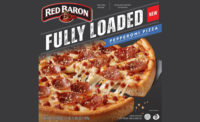SPIRIT OF INNOVATION AWARDS | 2003 RETAIL WINNERS
Schwan Food Company :: Red Baron Pizza Slices

Using premium ingredients to deliver robust, flavorful fillings, the development team sought to raise the quality bar for frozen microwave products. The addition of dried cheeses and herbs as a garnish to the top of the crust boosts both visual appeal and flavor. The Schwan Food Company (Marshall, Minn.) envisioned the Red Baron Stuffed Pizza Slice as “the first enrobed product that actually looks like a slice of pizza due to its triangular shape, golden brown crust and authentic crust lip.”
“This patent-pending technology, proprietary crust, triangular shape and microwave susceptor make it the only retail product of its kind,” says David Rettey, Schwan senior product development technologist.
Those unique attributes were the result of cutting-edge technology developed by cross-functional teams in regular communication with each other. Furthermore, the in-house developers also benefited from strong relationships with Schwan's packaging and equipment suppliers.

Shape Happens
Before development commenced, Schwan recognized the frozen snack and handheld segment was missing a high-quality, convenient, individual pizza-eating experience that appeals to both adults and kids. Red Baron has high household penetration in America, so the company opted to build on that familiarity to introduce a new approach to handheld pizzas.“The initial idea,” recalls Rettey, “was born internally and recognized almost immediately to be a significant opportunity for our company to leverage its pizza equity and manufacturing expertise to create a product that provides a quality eating experience from the microwave in minutes. A core team of internal experts was quickly identified to execute the concept. This team remained together throughout development and commercialization.”
The team also used its new product development process to facilitate communication among all elements of the company. In that way, Schwan created a company architecture to facilitate the ability to innovate through communication.
The More, The Merrier
Capitalizing on the intellect, ingenuity, experience and collaborative vision of multiple teams, Schwan's final goal was for Red Baron Stuffed Pizza Slices to create a new experience for consumers of handheld pizza snacks. The cross-functional team incorporated members of the company's research and development (R&D) department (notably product development), process engineering, sensory, regulatory affairs, culinary, and applied research. Other disciplines within the company, including sales and marketing, manufacturing, corporate engineering, and packaging services partners, also proved integral to the product's development.
“We also included external partners—a number of whom are strategically important to us,” said Rettey. “Together, we formed a process that allows us to be efficient.”
Rising to the Challenge
Joni Klimek, senior product development technologist, explains that in Schwan's system of product development, development typically begins with a paper concept, and “gold standard” protocepts are created around it. Approved protocepts soon evolve into bench-top prototypes, through the tandem efforts of product-development (PD) and process engineering (PE). PD and PE draw on resources and respective strengths to deliver commercially available raw materials and required equipment to recreate the original “gold standard” in a full-scale, commercial manufacturing plant.The sensory group becomes involved when the team is ready to introduce the product to the consumer. This team verifies that consumer needs and wants align with product attributes. At that point, regulatory affairs also join the team to ensure the newly developed product complies with proper standards of identity.
Initially, in the exploratory concept stage, Schwan's creates a cross-functional team that gathers around a table to discuss the product it is trying to develop. In that way, each team member from each respective discipline is on board, up to date and aware of design criteria and his respective responsibilities in delivering against success expectations. As such, each discipline is able to guide product development in such a way that resources (time, money, etc.) are used efficiently and all pertinent criteria are considered.
“One of the most important functions of this team was effective communication,” says Klimek. “Bringing people in early—building team support, momentum, excitement and enthusiasm—saved us a lot of development time.”
Once the teams were in place and in action, they were able to deal with any obstacles. One such challenge was the dough and process flows developed to produce Stuffed Pizza Slices. To avoid product-performance issues, the team had to design a new manufacturing line to deliver over-under sheeting and intermittent filling placement processes, both new to Schwan's. Part of the challenge was to figure out the most feasible means to synchronize bottom dough placement, filling deposit and reintroduction of a second dough sheet on top, all while simultaneously cutting the Stuffed Slice in such a way as to avoid exposed filling.
Topping the List
Similar difficulties centered around the addition of toppings. As Rettey explains, Schwan had to develop a type of tacky fluid substance for the outside of the product. Ultimately, a modified food starch would keep the toppings in place throughout the relatively rigorous life of the product: It must go from baking to freezing to packaging and shipping, maintaining product integrity throughout the process.In developing Red Baron Stuffed Pizza Slices, an upfront integration of consumer research and marketing expertise propelled the development team. In that way, each critical milestone was qualified against consumer expectations and market need. The result was an innovative product with high hedonic acceptance.
Such an acceptance demanded that the team spend many hours discussing the elegance parameters and creating “what-if” scenarios to eliminate the potential for a defective product. They used focus groups and concept testing to sketch the initial prototype, and modifications were refined on an ongoing basis to guarantee optimal performance and consistent delivery, in addition to consumer testing throughout the development.

Sidebar: Spirit of Innovation Awards
Honorable Mention for Packaging: Kraft Foods North America—Kool-Aid JammersWithin 10 months of identifying the potential for a totally new packaging concept, Kraft Foods (Northfield, Ill.) launched Kool-Aid Jammers. The signature, see-through pouch panel required the cooperation of various departments. Points to be considered included identifying package materials; testing machine compatibility and shelflife stability; verifying product and package compatibility; plus the development of graphics and incorporation of those traits into the Jammers' marketing and advertising efforts. The proprietary clear panel preserves the product's flavor and vitamin C content, while also showcasing its vivid colors.
Looking for a reprint of this article?
From high-res PDFs to custom plaques, order your copy today!









